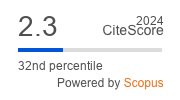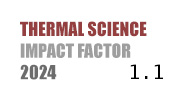THERMAL SCIENCE
International Scientific Journal
Thermal Science - Online First
online first only
Remaining working reliability of vertical fired heater with simultaneously used RBI matrix
ABSTRACT
This paper deals with the reliability of a vertical gas heater installed in an oil and gas plant, which has been in continuous operation for an extended period. It provides a classification of fired heaters based on their construction characteristics, and outlines their role within the gas rectification process, including the types of equipment involved. The general construction of the heater is described, along with key design and operational process parameters. The paper also identifies damage mechanisms that affect this type of equipment. A Risk-Based Inspection (RBI) analysis was conducted, and an RBI matrix was developed, indicating that the equipment falls into the high-risk category in terms of both financial consequences and environmental impact.
KEYWORDS
PAPER SUBMITTED: 2025-04-04
PAPER REVISED: 2025-05-07
PAPER ACCEPTED: 2025-05-08
PUBLISHED ONLINE: 2025-05-10
- Babysuaux, D., Oil and gas exploration and production : reserves, costs, contracts/with contributions, ISBN: 2710808404, editions: Technip, Paris, france 2004
- API 560-Fired heaters for general refinery service, Product no 56005, American Petroleum institute, Washington DC, USA, February 2016
- S.A. Mostafavi, A. Rezaei, Modelling of the fired preheater of crude oil considering the effect of geometrical parameters on fuel consumption, Heat Transfer 51 (2) (2021) 1425-1448
- S. Karem, M.A. Al-Obaidi, S. Alsadaie, Y.M. John, I.M. Mujtaba, Siginificant energy saving in industrial natural draught furnace: A model-based investigation, Applied Thermal Engineering 205 (2022), 117829
- Richard Yentumi, Bogdan Dorneanu, Harvey Arellano-Garcia,Optimal Operation of an Industrial Natural Gas Fired Natural Draft Heater,Chemical Engineering Journal Advances,Volume 11,2022, 100354,ISSN 2666-8211, doi.org/10.1016/j.ceja.2022.100354
- Jiří Hájek, Zdeněk Jegla,Standards for fired heater design: Analysis of two dominant heat flux variation factors,Applied Thermal Engineering,Volume 125,2017,Pages 702-713,ISSN 1359-4311, doi.org/10.1016/j.applthermaleng.2017.07.062
- Elsaid MR, Shoaib AM,Bhran AA, Awad ME. Developing of a monitoringsystem for evaluating and investigating the firedheater performance. Asia‐Pac J Chem Eng. 2019;14:e2314. doi.org/10.1002/apj.2314
- J. Hájek, Z. Jegla, J. Vondál, Numerical analysis of radiant section of fired heater focused on the effect of wall-tube distance, Computer Aided Chem. Engineer. 33(2014) 331-336
- M.D. Ahanj, M. Rahimi, A.A. Alsairafi, CFD modeling of a radiant tube heater, Int. Commun. Heat Mass Transfer 39 (2012) 432-438
- N. Parnian, Failure analysis of austenitic stainless steel tubes in a gas fired steam heater, Mater. Des. 36 (2012) 788-795
- A.M. Fuentes, M. Picón-Núñez, G.T. Polley, S. Méndez-Díaz, Analysis of the influence of operating conditions on fouling rates in fired heaters, Appl. Therm. Eng.62 (2014) 777-784
- A.M. Fuentes, G.T. Polley, M. Picón-Núñez, S. Martínez-Martínez, Modeling the thermo-hydraulic performance of direct fired heaters for crude processing, Appl.Therm. Eng. 39 (2012) 157-162
- S. Mussati, J.I. Manassaldi, S.J. Benz, N.J. Scenna, Mixed integer nonlinear programming model for the optimal design of fired heaters, Appl. Therm. Eng. 29(2009) 2194-2204
- A.K. Pramanick, G. Das, S.K. Das, M. Ghosh, Failure investigation of super heater tubes of coal fired power plant, Case Studies in Engineering Failure Analysis 9(2017) 17-26
- A. Movahedi-Rad, S.S. Plasseyed, M. Attarian, Failure analysis of superheater tube, Eng. Fail. Anal. 48 (2015) 94-104
- G. Das, S.G. Chowdhury, A.K. Ray, S. Das, D.K. Bhattacharaya, Failure of a super heater tube, Eng. Fail. Anal. 9 (2002) 563-570
- Z. Liang, X. Jin, Q. Zhao, Investigation of overheating of the final super-heater in a 660MW power plant, Eng. Fail. Anal. 45 (2014) 59-64
- H. Abbasfard, M. Ghanbari, A. Ghasemi, S. Ghader, H. Hashemipour Rafsanjani, A. Moradi, Failure analysis and modeling of super heater tubes of a waste heatboiler thermally coupled in ammonia oxidation reactor, Eng. Fail. Anal. 26 (2012) 285-292
- G.H. Farrahi, M. Chamani, K. Reza Kashyzadeh, A. Mostafazade, A.H. Mahmoudi, H. Afshin, Failure analysis of bolt connections in fired heater of a petrochemical unit,Engineering Failure Analysis,Volume 92,2018,Pages 327-342,ISSN 1350-6307, doi.org/10.1016/j.engfailanal.2018.06.004
- Morales-Fuentes, A., Picon-Nunez, M., Polley, T.G., Mendez-Diaz, S., Analysis of the infulemnce of operating conditions on fouling rates in fired heaters, Applied thermal engineering ,Volume 62, Issue, 2, pages: 777-784, Elesevier, Netherland, January 2014
- Jegla, Z., Vondal, J., Hajek, J., Standards for fired heater design: An assessments based on computational modelling, Applied thermal engineering, Volume 89, pages: 1068-1078, Elesevier, Netherland, October 2015
- Erfan Khodabandeh, Mahdi Pourramezan, Mohammad Hossein Pakravan, Effects of excess air and preheating on the flow pattern and efficiency of the radiative section of a fired heater, Applied Thermal Engineering, Volume 105, 2016, Pages 537-548, ISSN 1359-4311, doi.org/10.1016/j.applthermaleng.2016.03.038
- M. Haratian, M. Amidpour, A. Hamidi, Modeling and optimization of process fired heaters, Applied Thermal Engineering (2019), doi: doi.org/10.1016/j.applthermaleng.2019.113722
- Masoumi, M. E., & Izakmehri, Z. (2011). Improving of Refinery Furnaces Efficiency Using Mathematical Modeling. International Journal of Modeling and Optimization, 1(1), 74-79
- Al-Haj Ibrahim, H., & Al-Qassimi, M. (2010). Simulation of Heat Transfer in the Convection Section of Fired Process Heaters. Periodica Polytechnica Chemical Engineering, 54(1), 33-40. ResearchGate+5Periodica Polytechnica+5Academia+5
- Khodabandeh, E., Pourramezan, M., & Pakravan, M. (2016). Effects of Excess Air and Preheating on the Flow Pattern and Efficiency of the Radiative Section of a Fired Heater. Applied Thermal Engineering, 105, 490-499
- API RP 581, Risk-based Inspection Methodology. API Recommended Practice 581, third ed., American Petroleum Institute, Washington DC, USA, 2016
- D.G.S. Prayoga, DwiPriyanta, NurhadiSiswantoro,Comparative Analysis of Probability of Failure Determination Using Weibull Distribution and Generic Failure Frequencies on Heat Exchanger Tube Bundles Based on API 581, International Journal of Marine Engineering Innovation and Research, Vol. 2(3), June. 2018. 210-215
- ORADA 2015
- ANSI/API RP571, Damage Mechanisms Affecting Fixed Equipment in the Refining Industry, 3rd ed, American Petroleum Institute, Washington DC, USA, 2020
- API 580, API - RP 580, Risk-based Inspection, third ed., American Petroleum Institute, Washington DC, USA, 2016
- API 510, API Standard 510: Pressure Vessel Inspection Code: In-Service Inspection, Rating, Repair, and Alteration, 10th ed. American Petroleum Institute, Washington DC, USA, 2014
- API 560, API Standard 560: Fired Heaters for General Refinery Service, 5th ed. American Petroleum Institute, Washington DC, USA, 2016
- API 570, API Standard 570: Piping Inspection Code: In-service Inspection, Rating, Repair, and Alteration of Piping Systems, American Petroleum Institute, Washington DC, USA, 2024
- API 573, API Recommended Practice 573: Inspection of Fired Boilers and Heaters American, 4th ed, Petroleum Institute, Washington DC, USA,
- API 583, Corrosion Under Insulation and Fireproofing, American Petroleum Institute, Washington DC, USA, 2021
- API RP 579, API Recommended Practice 579-1/ASME FFS-1: Fitness-For-Service, 4th ed. American Petroleum Institute, Washington DC, USA, 2021

